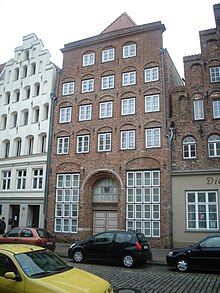Museum House Hanseatic City of Gdansk
The Museum Haus Hansestadt Danzig is located in Lübeck in the Engelsgrube in a brick building from the end of the 13th century. The museum was founded in 1981/1982 by the Danziger Förderkreis e. V. established. Through the arrangement and design of the rooms and the exhibits, the museum gives an impression of the culture of Gdańsk and the Gdańsk region up to the end of the Second World War .
Gdańsk region
The trading and Hanseatic city of Danzig was an independent city-state for centuries. In the years 1919–1939 it became the Free City of Danzig , after the Second World War it became Polish. In the entrance hall, which is designed in the style of a Gdansk town house, there are maps in which the geographical names are still in German, an address book of the former residents, seals and stamps as well as models of ships.
Networking the museum
Contact with institutions, citizens, scientific institutes and museums in Gdańsk is maintained. This applies in particular to the partnership agreement with the Museum of the History of the City of Gdańsk, Uphagen House Department (Dom Uphagena - Muzeum Historyczne Miasta Gdańska).
The museum is also a member of the Schleswig-Holstein Museum Association. V. in the German Museum Association
Memorabilia from Gdansk
The courtyard can be reached through the hall. Three church bells from Wotzlaff and Danzig are exhibited here, which were saved from the Hamburg bell cemetery. These bells were requisitioned in 1942 to be melted down for armaments production. In the hall and on the floors there are pictures, matchstick models of Gdańsk's Marienkirche and the Long Bridge, Gdańsk baroque furniture, festive robes, pewter and silver objects and complete rooms. Hanseatic chandeliers and wall blakers made of brass are in all rooms . These blakers reflect the light from the wall and the head side of the lighting source and are artistically designed. On the top floor there is a full-size reproduction of “The Last Judgment” by Hans Memling (1467–1473), the color and composition of which could have come from a contemporary painter.
Economy, customs and culture
One of the upper floors is dedicated to Gdansk as a commercial, garrison, tourist, educational and cultural city. The production of beer and Gdansk gold water in Gdansk is also documented. The uniform of a black hussar is on display. In addition, the escape and the destruction of the city are only discussed immediately after the end of the Second World War. The drawings of a contemporary witness of the ruins of well-known Gdansk buildings shortly after the end of the Second World War are also on display. (Documentation of the damage was strictly forbidden at the time.)
literature
- Danziger Förderkreis e. V .: Museum House Hanseatic City of Danzig. Leaflet from 1998
Web links
Individual evidence
- ↑ Dieter Leitner: Two new bells. Museum Haus Hanseatic City of Danzig in Lübeck. In: Das Ostpreußenblatt, special section of the Preußische Allgemeine Zeitung of October 30, 2010, p. 20
Coordinates: 53 ° 52 ′ 19.6 " N , 10 ° 41 ′ 6.4" E

